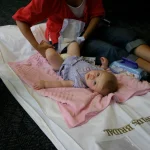Remember the joy of cuddling your newborn, their tiny hand grasped in yours, their breath a soft rhythm against your chest? Bed-sharing, or co-sleeping as it’s often called, can feel like an extension of this primal bond, a haven of warmth and comfort for both parent and child. But amidst the snuggles and sleepy smiles, questions arise: is bed-sharing safe? Can it actually benefit both parent and baby? And how can we navigate this intimate practice with confidence and peace of mind?
Beyond the Crib: Exploring the Benefits of Safe Bed-Sharing
While the American Academy of Pediatrics (AAP) advises against bed-sharing before six months of age, there’s a growing body of research highlighting the potential benefits of co-sleeping for both parents and babies. Here are just a few:

For Babies:
- Enhanced Bonding and Attachment: The close proximity of bed-sharing fosters a strong emotional connection between parent and baby, promoting feelings of security and trust.
- Improved Sleep Regulation: Studies suggest that co-sleeping can help babies regulate their sleep cycles, leading to longer stretches of peaceful sleep for both parties.
- Enhanced Breastfeeding: Bed-sharing makes nursing readily accessible, potentially contributing to longer breastfeeding durations and improved weight gain in babies.
- Reduced Stress and Crying: The soothing presence of a parent can help calm babies and reduce stress hormones, leading to less crying and more restful sleep.
For Parents:
- Increased Responsiveness to Baby’s Needs: Bed-sharing allows parents to respond quickly to feeding cues and comfort their baby instantly, reducing nighttime disruptions.
- Improved Mood and Reduced Stress: The oxytocin released during cuddling promotes feelings of calmness and bonding, potentially reducing parental stress and anxiety.
- Enhanced Parenting Confidence: The close connection fostered through co-sleeping can strengthen the parental bond and build confidence in caring for a new baby.
Navigating the Safe Sleep Waters: Essential Tips for Bed-Sharing
While the benefits of bed-sharing are undeniable, safety remains paramount. Here are some key tips to ensure a safe and healthy co-sleeping experience for you and your little one:
Before You Snuggle Up:
- Wait until your baby is at least six months old: This allows their respiratory and immune systems to mature and reduces the risk of sudden infant death syndrome (SIDS).
- Check your bed setup: Ensure there are no loose blankets, pillows, or toys near your baby’s face, and that the mattress is firm and flat.
- Avoid smoking and alcohol: These substances can impair your sleep quality and increase the risk of SIDS.
- Talk to your doctor: Discuss your specific situation and concerns with your pediatrician, who can provide personalized guidance for safe bed-sharing.
While You’re Snoozing:
- Sleep on your back: This is the safest position for both you and your baby.
- Avoid using sleeping pills or alcohol: These can impair your alertness and responsiveness to your baby’s needs.
- Keep the bed clutter-free: Remove pillows, blankets, and toys from the sleep space to avoid suffocation risks.
- Never fall asleep with your baby on a sofa or armchair: These are unsafe sleep environments due to the potential for falls.
Remember, You Can Always Change Course:
Bed-sharing is a personal choice, and it’s perfectly fine to adjust your approach as your baby grows and your needs change. If you feel uncomfortable or unsure, transitioning to a bassinet or crib attached to your bed can offer a safe alternative for some.
Co-Sleeping: Sweet Dreams or Suffocating Snuggles? Unraveling the Mystery (and Maximizing the Magic)
Ah, co-sleeping. The mere mention conjures images of blissful cuddles, soft lullabies, and a symphony of tiny breaths. But beneath the warm blanket of these ideal visions lurks a question that keeps parents up at night: is co-sleeping safe?
Fear not, weary warriors of the crib! This isn’t a battle between snuggles and sanity. Instead, let’s embark on a quest for knowledge, unearthing the truth about co-sleeping and maximizing its magic while prioritizing safety.
First, ditch the black-and-white answers. Co-sleeping isn’t a simple “yes” or “no.” It’s a nuanced dance between benefits and risks, and the safest approach depends on a constellation of factors:
- Your baby’s age: Tiny explorers under six months are still navigating their respiratory and immune systems, making co-sleeping potentially risky.
- Your health and sleeping habits: Smoking, alcohol, or sleep medications can compromise your responsiveness and increase risks.
- Your sleep environment: A firm mattress devoid of loose blankets and pillows becomes a fortress of safety.
- Your intuition: Listen to your gut! If you’re uncomfortable or unsure, prioritize alternative sleep arrangements.
But wait, there’s more! While risks exist, so do potential rewards:
- Enhanced bonding: Studies suggest co-sleeping strengthens the parent-child bond, promoting emotional security and healthy development.
- Improved breastfeeding: Increased accessibility can lead to longer nursing sessions and better weight gain for babies.
- Reduced stress and crying: The soothing presence of a parent can calm babies and lead to fewer tears and more peaceful sleep for everyone.
So, what’s the verdict? Co-sleeping can be a beautiful and enriching experience for many families, but it’s not a one-size-fits-all solution.
Here’s your co-sleeping compass:
- Gather knowledge: Consult your pediatrician for personalized guidance based on your specific situation and baby’s health.
- Prioritize safety: Follow safe sleep guidelines and create a secure sleep environment.
- Listen to your baby and yourself: Adjust your approach as your needs and your little one’s grow.
- Embrace the magic: Savor the closeness and enjoy the journey, knowing you’re making informed decisions for a safe and loving sleep haven.
Remember, co-sleeping is a choice, not a competition. Choose what feels right for you and your family, prioritize safety, and unlock the magic of shared sleep with confidence and peace of mind.
Bye-Bye, Sleepless Nights! How To Co-Sleep Safely and Enjoy Sweet Snuggles
Sharing your bed with your tiny treasure might sound like a recipe for blissful sleep, but navigating the world of co-sleeping can leave even the bravest parent feeling a little…lost. Fear not, sleepy warriors! This guide will equip you with the knowledge and tools to co-snuggle with confidence, ensuring both sweet dreams and safe slumber for you and your little one.
First things first: let’s dispel the myths! Co-sleeping isn’t inherently bad. In fact, for healthy babies over six months old, it can offer a wealth of benefits, from enhanced bonding and improved breastfeeding to reduced stress and crying. But like any powerful magic, it requires careful handling.
Here’s your safety spellbook:
1. Age is the Key: Before your little one graduates from bassinet to bed buddy, wait until they’re at least six months old. This gives their respiratory and immune systems time to mature, reducing the risk of SIDS.
2. Health is Your Compass: Consult your pediatrician! They can assess your baby’s health and offer personalized guidance based on any specific concerns.
3. Craft a Fortress of Safety: Your bed becomes your little one’s castle. Make sure the mattress is firm and flat, free from loose blankets, pillows, and toys that could pose a suffocation risk.
4. Sleep Position Potions: Snuggle safely! Both you and your baby should sleep on your backs, with your baby slightly below your chest level. Avoid using pillows near your baby’s head.
5. Listen to Your Intuition: This is your most potent spell. If you feel uncomfortable or unsure, don’t hesitate to adjust your approach. A bassinet or crib next to your bed can be a fantastic alternative.
Bonus Tip: Embrace the flexibility! As your little one grows and their needs change, adapt your co-sleeping style. Graduating to their own sleep space is a natural progression, not a failure.
Remember, co-sleeping is a journey, not a destination. Embrace the magic of shared sleep, prioritize safety, and trust your gut. With this guide as your map and your love as your compass, you’ll navigate the world of co-sleeping with confidence, creating memories as precious as the softest lullabies.

FAQs: Clearing the Clouds Around Co-Sleeping
Q: Is Every Snuggle a Safe Snooze? Navigating the Bed-Sharing Landscape for Your Unique Little One
Sharing your bed with your tiny adventurer might sound like a recipe for sweet dreams and cozy cuddles. But before you dive headfirst into co-sleeping, it’s natural to wonder: is it safe for every baby?
Here’s the honest scoop: Bed-sharing can be a beautiful and enriching experience for many healthy babies over six months old, but it’s not a one-size-fits-all solution. Just like every tiny explorer is unique, so is their journey to peaceful sleep.
Think of it like navigating a treasure map of safety precautions:
- Age is the golden compass: Generally, the AAP recommends waiting until your little one is at least six months old, giving their respiratory and immune systems time to mature.
- Health is your guiding star: Always consult your pediatrician. They can assess your baby’s individual health and offer personalized guidance based on any specific concerns.
- Your sleep environment is the map itself: Make sure your bed is a safe haven, free of loose blankets, pillows, or toys that could pose a suffocation risk. Firm and flat mattresses are the ultimate treasure!
- Listen to your inner navigator: If you’re ever uncomfortable or unsure, don’t hesitate to adjust your course. Transitioning to a bassinet or crib attached to your bed can be a fantastic alternative.
Remember, safe sleep is the ultimate treasure for every little one. By following these tips and prioritizing your baby’s well-being, you can unlock the magic of co-sleeping responsibly and confidently.
Bonus tip: Bookmark this map! Share it with other sleep-seeking adventurers and let’s build a community where every parent feels equipped to navigate the world of safe and sweet slumber.
Q: Will Snuggling Turn My Tiny Tiger into a Needy Monster? Dispelling the Bed-Sharing Spoil Myth
Ah, the age-old bedtime question: will sharing your bed with your little cuddle-bug turn them into a demanding, never-wants-to-be-alone monster? Fear not, brave parent, for the truth about bed-sharing and “spoiling” is far from scary!
Here’s the scoop: research shows no link between bed-sharing and spoiled behavior. In fact, studies suggest the opposite! This cozy co-sleeping can actually:
- Fuel the bond: Close proximity boosts oxytocin, the love hormone, strengthening the parent-child connection and fostering secure emotional development.
- Build confidence: Responding to your baby’s needs throughout the night, whether it’s feeding or soothing, can build trust and independence in the long run.
- Enhance self-regulation: Studies suggest co-sleeping can help babies learn to self-soothe and regulate their own sleep, leading to greater autonomy later in life.
But wait, there’s more! Sharing your bed doesn’t mean your little one will become perpetually attached. As they grow and develop, their need for physical closeness naturally changes. Just like you wouldn’t expect a teenager to crave constant cuddles, your little explorer will eventually graduate to their own sleep haven, all while cherishing the bond built during those snuggly co-sleeping days.
So, the bottom line: cuddling with your baby in bed isn’t a recipe for disaster. It’s a chance to build a foundation of love, trust, and emotional security, setting your little tiger up for a journey of independence with a heart full of warmth.
Bonus tip: Don’t hesitate to adjust your co-sleeping style as your baby grows. Transitioning to a crib next to your bed or even a separate room can be a smooth and natural progression as your little adventurer seeks their own sleep haven.

Q: Zzzzzz! Did My Snoozing Stop the Milk Flow? Navigating Accidental Bedtime Nursing
Ah, the blissful haze of nursing. You’re snuggled up, your little one is latched on, and the next thing you know, you’re drifting off on a lullaby of gentle gurgles… only to wake up with a jolt, wondering: “Did I just accidentally fall asleep while feeding my baby in bed?”
Don’t fret, mama! It happens to the best of us. Here’s how to navigate this sleepy situation with grace and safety:
First things first:
- Check your little one’s position. Make sure they’re still safely on their back, with no loose blankets or pillows within reach.
- Assess their breathing: If they’re still nursing actively and breathing normally, you can relax and enjoy your unexpected snooze.
- Listen to your instincts: If you’re feeling worried or uncomfortable, it’s always better to err on the side of caution.
Here’s your safety toolbox:
- Move your baby: If you wake up concerned, gently transfer them to a crib or bassinet once they’ve finished nursing.
- Clear the bed: Remove any blankets, pillows, or toys that could pose a suffocation risk before snuggling back in.
- Consult your pediatrician: If you have any concerns about your baby’s well-being, always reach out to your doctor for personalized advice.
Bonus tip: Invest in a nursing pillow or dock that can help keep your baby comfortably positioned while you’re both relaxed and snuggled up.
Remember, accidental bed-nursing happens! Don’t beat yourself up. It’s important to prioritize both your own sleep and your baby’s safety. By following these tips and trusting your instincts, you can navigate these sleepy situations with confidence and peace of mind.
Conclusion: Sweet Dreams and Shared Slumber
Bed-sharing can be a beautiful and enriching experience for both parents and babies. It can be a haven of comfort, a place to forge a deep bond, and a source of shared sleep and tranquility. But it’s important to approach it with knowledge, awareness, and a commitment to safety. By following the recommendations provided and prioritizing your baby’s well-being above all else, you can navigate the world of co-sleeping with confidence and reap the potential rewards of this intimate practice.
Remember, every family and every baby is unique. There is no one-size-fits-all approach to sleep, and what works for one family may not work for another. The key is to listen to your instincts, trust your pediatrician’s guidance, and create a safe and loving sleep environment that feels right for you and your little one.
Sweet dreams and shared slumber await!
P.S. Don’t forget to share your co-sleeping experiences and tips with us! Tag us in your photos and stories using #SafeSleepSharing and #BedtimeBond, and let’s build a supportive community for families navigating the world of sleep and snuggles.



